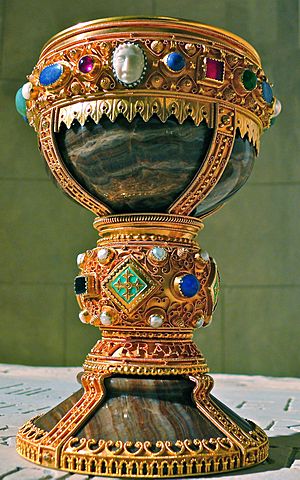Chalice of Doña Urraca facts for kids
The Chalice of Doña Urraca is a beautiful cup covered in jewels. It is made from a stone called onyx. This special chalice is kept at the Basilica of San Isidoro in León, Spain. It once belonged to Urraca of Zamora, who was a princess and the daughter of Ferdinand I of Leon.
In March 2014, two Spanish authors, Margarita Torres and José Ortega del Rio, suggested that this chalice might be the famous Holy Grail. This idea was new, as no one had ever said this about the chalice before. Many historians and experts did not agree with this claim. They said the chalice was made in the mid-11th century, based on its materials and how it was crafted. However, the claim made many people want to see the chalice. So many visitors came that the basilica had to create a special room just for it.
Contents
Where to Find It
The Chalice of Doña Urraca is kept at the Basilica of San Isidoro in León, Spain. Historians believe it has been there since the 11th century.
When the book The Kings of the Grail was published in 2014, claiming the chalice was the Holy Grail, the museum staff had to take it off display quickly. Too many people wanted to see it at once! Now, the museum shows the chalice in its own special room. This room is in the tower, next to the old library.
The Holy Grail Claim
Authors Margarita Torres and José Ortega del Rio wrote a book called The Kings of the Grail. In March 2014, they claimed they had found out where the chalice came from. They said it started with early Christian groups in Jerusalem.
How the Story Began
The researchers believe the chalice was taken to Cairo by Muslim travelers. Later, it was given to a ruler on the Spanish coast. This ruler had helped people in Egypt during a time of hunger. From there, the chalice came into the hands of King Ferdinand I of Leon. He was the father of Urraca of Zamora. The chalice was given to him as a peace offering by a ruler from Al-Andalus, a Muslim kingdom in Spain.
What Experts Say
Some ideas suggest the chalice was made a very long time ago, between 200 BC and 100 AD. According to Margarita Torres, "the only chalice that could be considered the chalice of Christ is that which made the journey to Cairo and then from Cairo to León — and that is this chalice." However, it is not certain if Jesus actually used this specific cup. Archaeologists point out that about 200 different cups and chalices across Europe are also said to be the Holy Grail.
Seeing It Up Close
To make the chalice easier for everyone to see, it was made digital in 2017. It was turned into a 3D model. Visitors to the museum can now wear VR (virtual reality) glasses. This lets them have the experience of holding the virtual chalice in their hands. They can look at all its details very closely.
See also
 In Spanish: Cáliz de doña Urraca para niños
In Spanish: Cáliz de doña Urraca para niños


